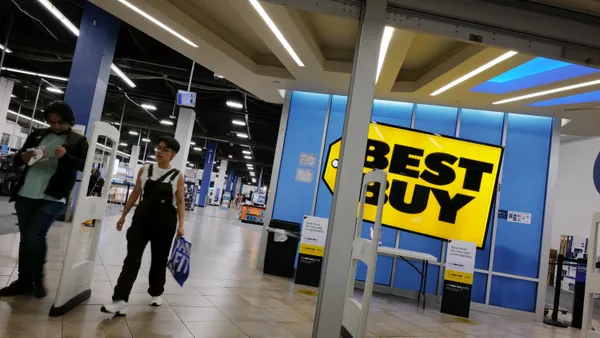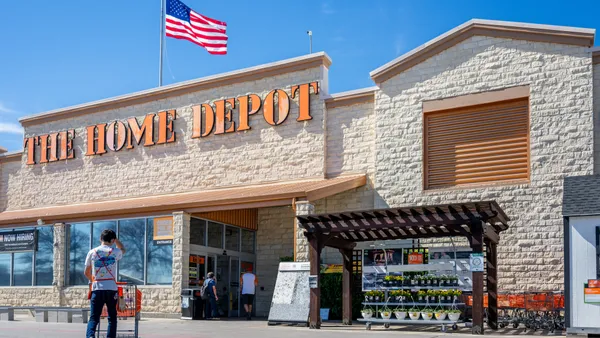Dive Brief:
-
Urban Outfitters, which runs Anthropologie, BHLDN, Free People, Terrain and Urban Outfitters, as well as a food and beverage division, on Monday said that total company sales in its third quarter of fiscal 2018 rose 3.5% over the same quarter last year to a record $893 million, according to a company press release. Within its retail operations, its direct-to-consumer channel continued to outperform its store channel driven by increases in sessions and conversion rate, which more than offset a small decrease in average order value, executives told analysts Monday, according to a conference call transcript from Seeking Alpha.
-
By brand, same-store sales at Free People rose 5%, 2% at Anthropologie and 1% at Urban Outfitters, the company said, including an adjustment from hurricane-related impacts on the measure that represents approximately two-thirds of a point at each of the brands. September and October were positive same-store months. During the third quarter, the company opened two Anthropologie locations and two Free People locations, all in North America. During the nine months ended Oct. 31, the company opened 16 new locations, including eight Free People stores, four Urban Outfitters stores, three Anthropologie Group stores and one restaurant, and closed six, including three Free People stores, one Urban Outfitters store, one Anthropologie Group store and one restaurant.
-
In addition to Free People's retail strength, including 8% sales growth in the quarter and expanded margins leading to stronger operating income for the brand, that brand's wholesale sales rose 9% driven by domestic and international growth in department stores, specialty stores and direct-to-consumer, the company said. Its athletic FP Movement sales grew 36% year over year, supported by 21 physical locations, 19 within Free People stores and two free standing pop-up shops.
Dive Insight:
Urban Outfitters spent the past few months digging itself out of sales declines, stemming from fashion misses and lackluster e-commerce, that executives on Monday said have been profoundly reversed.
"When I spoke on this call three months ago, I voiced my disappointment in our second quarter results and stated the sales shortfall came primarily from our lack of execution rather than macro headwinds," CEO Richard Hayne told analysts. "I expressed confidence there was sufficient fashion newness to drive positive comp sales. Today, I am pleased to report that all brands executed well in Q3."
Indeed, the company's results make for "happier reading," GlobalData Retail Neil Saunders told Retail Dive in an email. "The 3.5% uplift in total sales is welcome, but it is the return of all brands to positive comparable sales that is most agreeable," he said. "This rise came despite the negative impact of the hurricanes on some stores: without this, overall comparable sales would have risen by 2% rather than the reported 1%."
Still, like Gap with Old Navy and Abercrombie & Fitch with Hollister, Urban Outfitters is relying a bit too much on its Free People brand. Although, unlike those retailers, Free People isn't lower-priced than its siblings. Anthropologie and Urban Outfitters stores are nice, or as Saunders puts it, "not unpleasant," but it can be difficult for customers to shop there, he said. It's easier to sort through merchandise online, which is partly why online sales are better.
"Free People does a much better job at creating a unique and interesting offer, which is one of the reasons its performance has been so much better," he noted. "However, the Urban Outfitters' over-reliance on this brand is problematic. To sustainably boost performance the company needs to be firing on all cylinders, not just one."
The brands are specialists in out-of-the-box styling — what Lee Peterson, EVP of brand strategy and design at design firm WD Partners, calls the "third wave," which can save a brand from margin-killing discounts and, most importantly, get people's attention and dollars.
"Third wave is 'I'm really cool. I'm Shake Shack.' Even Forever 21," Peterson said. "Urban Outfitters, really funky, those are big guys playing in the third wave. ... It's the same with restaurants. McDonald's, Walmart, dollar stores, nobody's going to say 'cool.' Discount, maybe convenience if you ship it to my home, but not third wave."
But Saunders says some of the clothing there is too eclectic. "Fall and winter ranges appear to have a little more cohesion," he said. "Even so, Urban Outfitters, and to a lesser extent Anthropologie, are still dropping off the radar of some consumers. To remedy this, both brands need to develop a much clearer and more compelling handwriting that resonates with the core customer."
More alarming is the disparity between the company's overall physical and e-commerce performance, Saunders warned, noting that its stores are in decline while its e-commerce is growing. "Although the two trends balance each other out in sales terms, the impact on profit is negative because of the higher costs associated with fulfillment," he said. "This is not a new dynamic, but it is one that Urban Outfitters is still largely failing to address."













